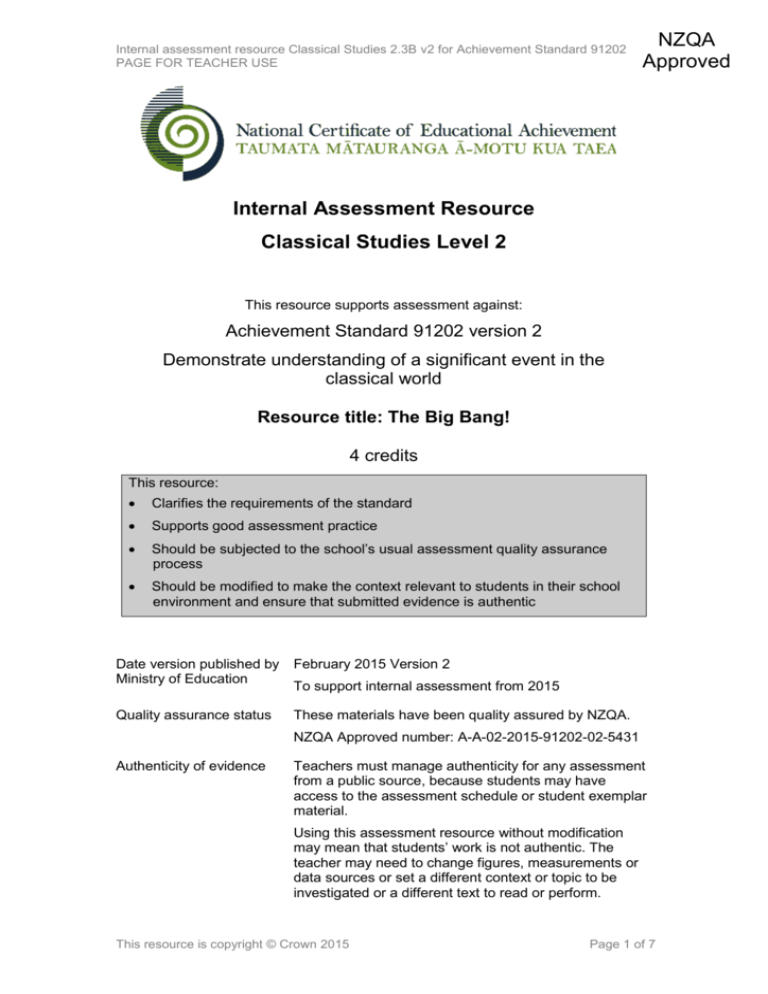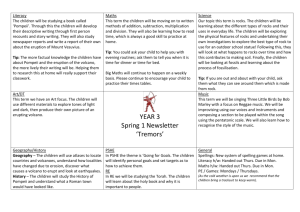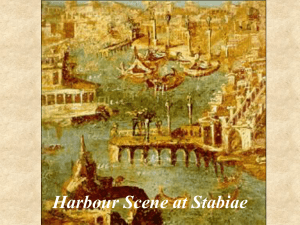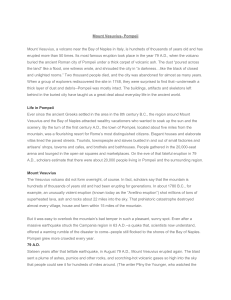2.3 Bv2 (Word, 140 KB)
advertisement

Internal assessment resource Classical Studies 2.3B v2 for Achievement Standard 91202 PAGE FOR TEACHER USE NZQA Approved Internal Assessment Resource Classical Studies Level 2 This resource supports assessment against: Achievement Standard 91202 version 2 Demonstrate understanding of a significant event in the classical world Resource title: The Big Bang! 4 credits This resource: Clarifies the requirements of the standard Supports good assessment practice Should be subjected to the school’s usual assessment quality assurance process Should be modified to make the context relevant to students in their school environment and ensure that submitted evidence is authentic Date version published by Ministry of Education February 2015 Version 2 Quality assurance status These materials have been quality assured by NZQA. To support internal assessment from 2015 NZQA Approved number: A-A-02-2015-91202-02-5431 Authenticity of evidence Teachers must manage authenticity for any assessment from a public source, because students may have access to the assessment schedule or student exemplar material. Using this assessment resource without modification may mean that students’ work is not authentic. The teacher may need to change figures, measurements or data sources or set a different context or topic to be investigated or a different text to read or perform. This resource is copyright © Crown 2015 Page 1 of 7 Internal assessment resource Classical Studies 2.3B v2 for Achievement Standard 91202 PAGE FOR TEACHER USE Internal Assessment Resource Achievement Standard Classical Studies 91202: Demonstrate understanding of a significant event in the classical world Resource reference: Classical Studies 2.3B v2 Resource title: The Big Bang! Credits: 4 Teacher guidelines The following guidelines are supplied to enable teachers to carry out valid and consistent assessment using this internal assessment resource. Teachers need to be very familiar with the outcome being assessed by Achievement Standard Classical Studies 91202. The achievement criteria and the explanatory notes contain information, definitions, and requirements that are crucial when interpreting the standard and assessing students against it. Context/setting This activity requires students to write text and assemble relevant illustrations for a talk examining the context of a significant event – the eruption of Vesuvius in 79 CE. This will enable them to show insight into why the eruption was important and to explain its significance in preserving information about ancient Roman everyday life. Students must support their explanations with primary source evidence that relates specifically to the context. While not a requirement of the standard at any level of achievement, students are strongly encouraged to use secondary source material to support points made. This may allow students to examine, with perception, a significant event in the classical world. Primary sources include evidence surviving from the classical world, including written material in translation and artefacts of all kinds. Secondary sources include evidence drawn from later commentaries, for example, books, websites, encyclopaedias, and later works of art and architecture. Before adapting this resource for a different context, you will need to select/finalise/ negotiate a context that will engage students, work out exactly how the assessment will be applied to this context, create or finalise any student pages that are needed, and ensure that the assessment schedule aligns with the activity in its final form. Conditions This assessment task will take two weeks of in- and out-of-class time. Students may work in groups to gather evidence and develop their ideas. However, they will need to submit their own work for assessment and will be assessed individually. Students should submit an accurate reference list or bibliography that includes all sources they have used in this activity. It will not be assessed, but will be used for authentication purposes. This resource is copyright © Crown 2015 Page 2 of 7 Internal assessment resource Classical Studies 2.3B v2 for Achievement Standard 91202 PAGE FOR TEACHER USE Resource requirements Teachers need to select resources to suit their chosen context. Resources suitable for the eruption of Vesuvius: A Day in Pompeii, Museum Victoria 2009. A Pompeian Notebook, Putini, L’Erma di Bretschneider 2002. Atlas of Classical History, Talbert, Routledge 1988. Cities of Vesuvius, Grant, Phoenix 2001. Great Treasures of Pompeii and Herculaneum, Feder, Abbeville Press 1978. Pompeii, Andrews, Cambridge University Press 1988. Pompeii, Connolly, Oxford University Press 1990. Pompeii, Lessing/Varone, Terrail 1996. Pompeii, The Day a City Died, Etienne, Thames and Hudson 1992. Roman Pompeii, Laurence, Routledge 1994. In addition you may find helpful material on the following websites: Pompeii http://www.bbc.co.uk/history/ancient/romans/pompeii_portents_01.shtml. Eruption of Vesuvius http://www.arch.virginia.edu/struct/pompeii/volcanic.html. A Day in Pompeii http://ancienthistory.about.com/od/pompeii/ig/A-Day-inPompeii/. Additional information Students are not assessed on the application of a methodology of inquiry. However, this activity does provide an opportunity for students to learn a methodology of inquiry prior to the activity. Identify each step of this process, making it clear that this is not part of the assessment activity but part of their prior learning. This resource is copyright © Crown 2015 Page 3 of 7 Internal assessment resource Classical Studies 2.3B v2 for Achievement Standard 91202 PAGE FOR STUDENT USE Internal Assessment Resource Achievement Standard Classical Studies 91202: Demonstrate understanding of a significant event in the classical world Resource reference: Classical Studies 2.3B v2 Resource title: The Big Bang! Credits: 4 Achievement Demonstrate understanding of a significant event in the classical world. Achievement with Merit Achievement with Excellence Demonstrate in-depth understanding of a significant event in the classical world. Demonstrate perceptive understanding of a significant event in the classical world. Student instructions Introduction This activity requires you to write text and to assemble relevant illustrations in a slide show for a talk about the significance of the eruption of Mt Vesuvius in 79 CE. Aim to show insight into why the eruption was important. Place the eruption in context and explain its significance in preserving information about ancient Roman everyday life. Teacher Note: suggestions for other formats: - an interview with an archaeologist - an archaeologist’s written advice, supported by evidence, to a modern Italian city council wanting to develop some land, not yet excavated, at Pompeii - an investigation scrapbook for a Guide or Scout or NZ Challenge badge - poster for a classroom - booklet suitable for Year 7/8 - journalist’s article for a newspaper. Alternative suggestions for events (others are possible): - the reforms of Solon 594-593 BCE or of Cleisthenes c.500 BCE the issue of the Megarian Decree by Pericles 432 BCE the invitation to the Romans to help rid Sicily of the Carthaginians 264 BCE the election of Marius as Roman consul in 107 BCE the resignation of Sulla from the dictatorship in 79 BCE the crossing of the Rubicon by Julius Caesar 49 BCE the assassination of Pompey the Great 48 BCE the landings in Britain by Julius Caesar 55-54 BCE the siege of Masada 73 CE. The extent to which you show insight into the importance of the eruption by giving informed explanation (including primary evidence) will determine the overall grade. You have two weeks of in and out-of-class time for this task. Teacher note: you may wish to insert a different time period here. This resource is copyright © Crown 2015 Page 4 of 7 Internal assessment resource Classical Studies 2.3B v2 for Achievement Standard 91202 PAGE FOR STUDENT USE You have studied some of the art and architecture of ancient Pompeii. In this activity you will be demonstrating perceptive understanding of a range of aspects/factors of the volcanic eruption that buried that city and several others, to explain its significance. Task Write the text for an illustrated talk examining the importance of the eruption of Mt Vesuvius for our knowledge of Roman everyday life. Make reference to translated extracts from ancient authors in your talk and assemble relevant illustrations of works of art/architecture in a slide show in order to provide primary evidence to support what you are saying. In your written text place the eruption in context and examine a range of aspects/factors contributing to the importance of the eruption. To place the event in context, explain such aspects/factors as: The type of eruption, the time of day that it occurred and weather conditions at the time. The location of towns around the mountain (show this information on a map). The types of people excavating and the varying difficulties they faced. Present information about 1st century BCE Roman life available from examination of artefacts and buildings buried by the eruption. (Focus on information that is not as readily available from other ancient sites.) Aspects/factors that you could demonstrate perceptive understanding of are: Teacher note: you will need to insert here the aspects/factors to be examined. You may wish to advise students wanting to choose their own aspects/factors to consult you about whether their choices are appropriate. You may include other aspects. A written text with relevant illustrations demonstrating perceptive understanding might include: reasons for similarities and differences e.g. in the effects of the eruption on different towns cultural expectations and codes of behaviour e.g. different motives of people excavating the sites, unique evidence of the nature of everyday life preserved by the effects of the eruption recognition of limitations of sources of evidence. As you write your text take care to evaluate the importance of the eruption. You should submit an accurate reference list or bibliography that includes all sources that have used in this activity. It will not be assessed, but will be used for authentication purposes. This resource is copyright © Crown 2015 Page 5 of 7 Internal assessment resource Classical Studies 2.3B v2 for Achievement Standard 91202 PAGE FOR TEACHER USE Assessment schedule: Classical Studies 91202 The Big Bang! Evidence/Judgements for Achievement The student has written an illustrated text that places the eruption in context and gives explanation, through the inclusion of primary evidence, of the significance of the eruption. For example: an explanation of a discovered wall painting of the Harbour at Stabiae, with a conclusion: In the Museo Nazionale there is a wall painting of the harbour at Stabiae on display (about 24.5 cm square), that was originally part of a wall of a villa in the town of Stabiae. This picture tells us that the owner of the house liked the view of the harbour, and had sufficient income to pay a Greek artist to reproduce the scene in his house. It survived being buried by the eruption and so either from photographs or in the Naples Museum today we are able to appreciate its colours and the techniques used to depict the scene. Evidence/Judgements for Achievement with Merit Evidence/Judgements for Achievement with Excellence The student has written an illustrated text that places the eruption in context and gives informed explanation, through the inclusion of relevant primary evidence, of a range of aspects/factors contributing to the significance of the eruption. The student has written an illustrated text that places the eruption in context and gives an explanation that shows insight, through the inclusion of relevant primary evidence, of a range of aspects/factors contributing to the significance of the eruption. For example: an informed explanation of a discovered wall painting of the Harbour at Stabiae, with a conclusion: In the Museo Nazionale there is a 24.5 cm square wall painting of the harbour at Stabiae on display which was originally part of a wall of a villa in the town of Stabiae. This town was south of Pompeii and it was on its beach that Pliny the Elder died from the sulphurous fumes in the air just after the eruption. The choice of subject for this picture may mean that the owner of the house liked the view of the harbour, or perhaps had a boat at, or did business through, that harbour, and had sufficient income to pay (probably) a Greek artist to reproduce the scene of the busy harbour in his house. The fact that it was buried for some 1800 years meant that without major damage it survived long enough for us to appreciate the type of painting that was valued at the time for a house’s wall decoration. Also included: a reproduction of the wall painting. This resource is copyright © Crown 2015 For example: a perceptive explanation of a discovered wall painting of the Harbour at Stabiae, with a developed conclusion: In the Museo Nazionale there is a 24.5 cm square wall painting of the harbour at Stabiae saved from a villa in the town of Stabiae, situated 5 km south of Pompeii. The owner of the villa must have commissioned this scene because he wanted to brighten the wall and/or because it was a favourite view. Pliny, nephew of Pliny the Elder, the natural scientist, who after the eruption headed for Stabiae by ship to rescue people there, recorded his uncle’s observations at the time. He wrote that this town was affected by a very deep layer of ‘ashes mixed with pumice stones’. So this was likely to have been the material that for close to 1800 years prevented sunlight and moisture from destroying the picture. While the older Pliny lay down for a rest at Stabiae, the ash and pumice reached such a height that he barely got out of the building’s door. He died on the beach from the sulphurous fumes in the air not long afterwards; these fumes would no doubt have ruined the painting too, had it not Page 6 of 7 Internal assessment resource Classical Studies 2.3B v2 for Achievement Standard 91202 PAGE FOR TEACHER USE already have been covered by ash. Now that the painting has been carefully uncovered from metres of ash, overtopped by fertile soil that has built up since, and transported to the Naples Museum, we are able to appreciate the mixture of ground level and bird’s eye views used by the painter to include much detail of the port’s activities. Hanfmann wrote of this painting “this gem of ancient topographical painting resembles . . . an aerial photograph.” It is unlikely that a painting hanging on a wall as we would know it today, and exposed to sunlight and the atmosphere for so long, would still exist for us to examine. The eruption was a disaster for those alive at the time, but it did preserve items that we, generations later, are able to study. Also included: a reproduction of the wall painting and a map showing the location of Mt Vesuvius, Pompeii and Stabiae. Final grades will be decided using professional judgement based on a holistic examination of the evidence provided against the criteria in the Achievement Standard. This resource is copyright © Crown 2015 Page 7 of 7








